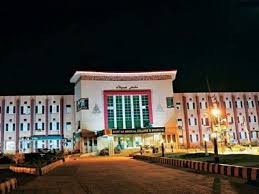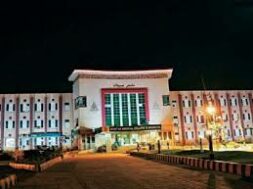
Pakistan: Controversy over Rotting Human Bodies
Manas Dasgupta
NEW DELHI, Oct 15: Controversy has erupted in Pakistan over alleged mal-treatment of dead bodies throwing them up on the rooftop of a hospital for rotting instead of giving them a decent burial.
Two inquiry committees have been set up by the concerned authorities for a probe into the report that over 200 rotting corpses were found on the roof of Nishtar Hospital in Pakistan’s Multan city on Friday.
As per social media, hundreds of human body parts have also been recovered from the roof of the Hospital’s mortuary after which the Punjab government decided to probe the incident. The Punjab government formed a six-member committee to investigate the incident after the bodies were discovered and videos and pictures were shared on the internet. The Nishtar Medical University’s vice-chancellor has also formed a three-member committee for an inquiry into the incident.
According to sources, dozens of bodies are rotting in the room built on the roof of Nishtar Hospital. On the other hand, according to the news circulating on social media, hundreds of human body parts have been recovered from the roof. No confirmation or denial has been given yet, however, by any government official over the number of bodies.
Advisor to Chief Minister, Punjab, Tariq Zaman Gujjar said a whistleblower tipped him off about the rotting bodies on the roof of the mortuary at Nishtar Hospital. “I was on a visit in Nishtar Hospital when a man approached me and said if you want to do a good deed then go the morgue and check it out,” Gujjar said.
He said when he reached there the staff wasn’t ready to open the doors of the mortuary. “To this, I said if you don’t open it right now, I am going to file an FIR against you,” Gujjar added. He said when the morgue was finally opened and they stepped in only to find at least 200 bodies lying around. “All the decomposing bodies [of both men and women] were bare. Even women’s bodies weren’t covered.”
Gujjar said when he asked them (doctors) to explain what was going on they said these were used by the medical students for educational purposes. “Do you sell these bodies? I asked the mortuary authorities.”
Gujjar said he asked doctors to explain the incident and in response, they said it was not what it looked like as these were used by the medical students for educational purposes. “Two of the bodies on the roof were rather in the early stages of decomposition. Maggots were all over them,” Gujjar said. He said he had never seen anything like it in his 50 years of life.
“Vultures and worms were scavenging on the corpses on the roof. Our tally showed there were at least 35 bodies on the rooftop of the mortuary.” “The bodies after being used for medical education purposes should have been given a proper burial after Namaz-e-Janaza, but they were thrown on the roof,” Gujjar said.
There, however, was another version of the entire saga to establish that nothing was wrong and only four bodies were kept legally for educational purposes and not “over 200” as earlier reported. It said that on receiving reports of abandoned bodies on the hospital roof, the Punjab chief minister ordered his Adviser, Chaudhry Tariq Zaman Gujjar, to pay a surprise visit to the medical facility and submit a report after reviewing the situation.
Contrary to initial reports of the presence of 500 bodies, only four were there, as could be seen in a now viral video of the CM adviser’s visit.
Some reports claim that the Nishtar Medical University (NMU) administration was worried about the surprise visit and opening the door of the hospital’s roof. According to a spokesperson for NMU, four sets of human remains were found on the roof, all largely decomposed. According to the standard operating procedures (SOPs) issued by the home department, a letter was sent to the central police office for the burial of the bodies.
Anatomy Department chief Dr Maryam Ashraf, while claimed that the unidentified bodies brought by police were chemically treated and stored in the freezer, provided the process of decomposition had not started. She added that if nobody claimed a body for a month, the police were informed about it and it was used for teaching students, according to the prevailing norms of the home and health departments.
Dr Maryam said some bodies were brought to the hospital in such a state that the process of decomposition had already set in and it was impossible to keep them in the mortuary. “These corpses are kept in rooms built on the roof for many years and after complete putrefaction, their skeletons are removed and cleaned with chemicals for teaching purposes. This process is not illegal,” she added.
Additionally, some bodies are so badly decomposed that they cannot be used even for teaching purposes. After the bones are removed, these bodies are buried as per the SOPs. The NMU spokesperson said the bodies found on the hospital roof were buried by the police station concerned, while investigations were under way about them.
Sources claimed that the unidentified abandoned bodies found on the roof of the hospital were brought by the police and placed on the roof, while the anatomy department staff delayed placing them in their designated rooms.
Dr Maryam maintained that the practice of putrefying bodies on the roof of NMU would continue until the SOPs changed. She added that the incident was an attempt to politicise the issue.
The HOD reasoned that these are the unidentified bodies handed over by the police to them for post-mortem and “if required” to be used for teaching purposes for MBBS students. “We have a cold storage where we keep bodies. The police bring unidentified bodies to the hospital. The decomposition process in these bodies has already begun. These bodies are kept in rooms on the roof. All of this is done in accordance with the guidelines of the home and health departments. The impression of 500 or 5,000 bodies being present [on the hospital roof is entirely incorrect,” she added.
However, the CM’s adviser expressed anger with the practices of NMU’s Anatomy Department. On seeing the bodies, he said such desecration would not be tolerated under any circumstances. He directed that arrangements should be made immediately to ensure that no bodies were thrown on the roof. “The abandoned dead should be buried,” he concluded.
Notably, Pakistan has emerged as a global leader in cases of enforced disappearances as hundreds simply ‘disappear’ in the country every month as over 8,000 people have gone missing in the country since 2001. This comes after the Human Rights Commission of Pakistan (HRCP), the non-government watchdog, expressed concern over citizens’ faulty disappearances. Over 6,500 Baloch and 5,000 Pashtuns remain on the ‘missing’ list and their whereabouts remain unknown.
As per the media reports, the Islamabad High Court in January 2021 ruled in a 2015 disappearance case that the prime minister has to take entire responsibility as the state failed terribly in protecting its citizens. Moreover, in October 2017, the top court of Pakistan ordered the interior ministry to provide a detailed account of everyone being held however the cases of disappearances only skyrocketed, the report added.
People being forcibly disappeared is a severe and longstanding issue in Pakistan. Hundreds of thousands of people from all spheres of life started to disappear. In March 2011, the Commission of Inquiry on Enforced Disappearances (COIOED) was formed to work on the issue.
According to recent figures released by COIOED in July 2022, 8,696 missing person cases have been reported. While 6,513 of these cases have been solved, 2,219 are still pending. Despite efforts by civil society, there is no end to the issue of enforced disappearances in Pakistan, as the state continues to use it with impunity.
The irony is that successive Pakistani governments have pledged to end the practice of enforced disappearances, however, there is no end to it, reported the Canada-based think tank International Forum for Rights and Security (IFFRAS).














